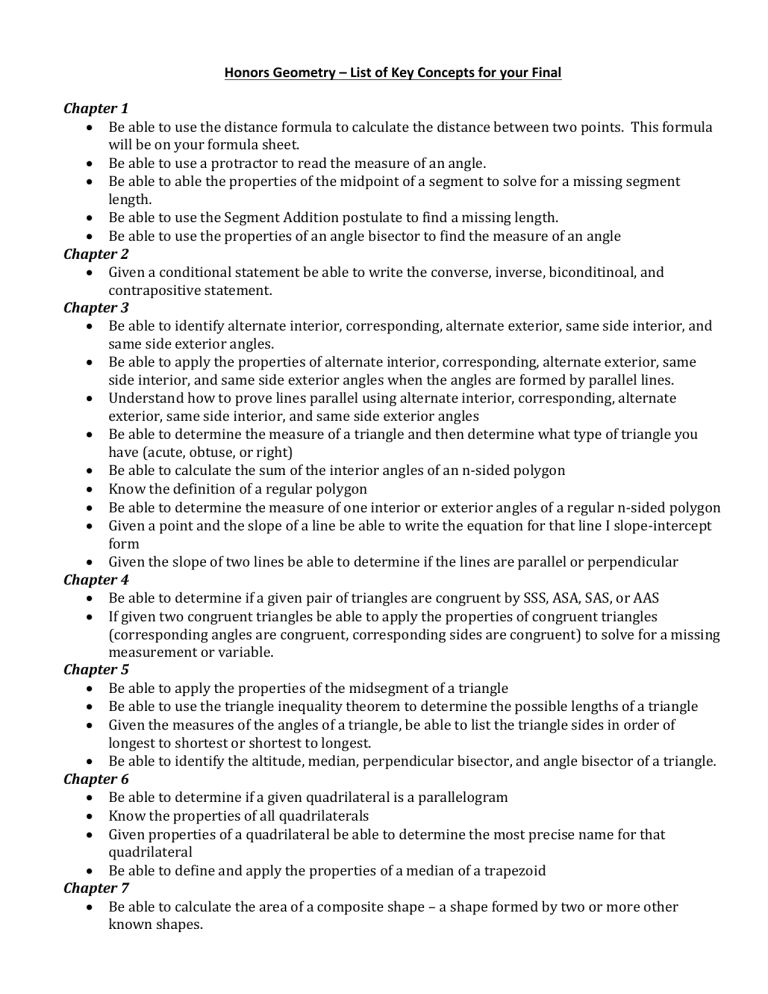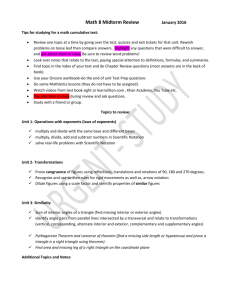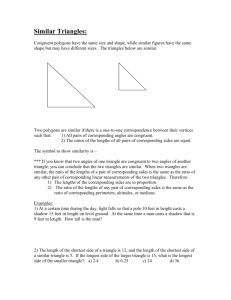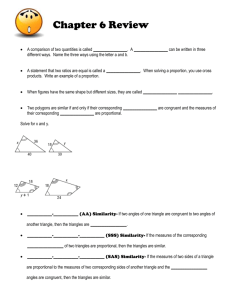Honors Geometry – List of Key Concepts for your Final Chapter 1 Be

Honors Geometry – List of Key Concepts for your Final
Chapter 1
Be able to use the distance formula to calculate the distance between two points. This formula will be on your formula sheet.
Be able to use a protractor to read the measure of an angle.
Be able to able the properties of the midpoint of a segment to solve for a missing segment length.
Be able to use the Segment Addition postulate to find a missing length.
Be able to use the properties of an angle bisector to find the measure of an angle
Chapter 2
Given a conditional statement be able to write the converse, inverse, biconditinoal, and contrapositive statement.
Chapter 3
Be able to identify alternate interior, corresponding, alternate exterior, same side interior, and same side exterior angles.
Be able to apply the properties of alternate interior, corresponding, alternate exterior, same side interior, and same side exterior angles when the angles are formed by parallel lines.
Understand how to prove lines parallel using alternate interior, corresponding, alternate exterior, same side interior, and same side exterior angles
Be able to determine the measure of a triangle and then determine what type of triangle you have (acute, obtuse, or right)
Be able to calculate the sum of the interior angles of an n-sided polygon
Know the definition of a regular polygon
Be able to determine the measure of one interior or exterior angles of a regular n-sided polygon
Given a point and the slope of a line be able to write the equation for that line I slope-intercept form
Given the slope of two lines be able to determine if the lines are parallel or perpendicular
Chapter 4
Be able to determine if a given pair of triangles are congruent by SSS, ASA, SAS, or AAS
If given two congruent triangles be able to apply the properties of congruent triangles
(corresponding angles are congruent, corresponding sides are congruent) to solve for a missing measurement or variable.
Chapter 5
Be able to apply the properties of the midsegment of a triangle
Be able to use the triangle inequality theorem to determine the possible lengths of a triangle
Given the measures of the angles of a triangle, be able to list the triangle sides in order of longest to shortest or shortest to longest.
Be able to identify the altitude, median, perpendicular bisector, and angle bisector of a triangle.
Chapter 6
Be able to determine if a given quadrilateral is a parallelogram
Know the properties of all quadrilaterals
Given properties of a quadrilateral be able to determine the most precise name for that quadrilateral
Be able to define and apply the properties of a median of a trapezoid
Chapter 7
Be able to calculate the area of a composite shape – a shape formed by two or more other known shapes.
Be able to find the area and circumference of a circle
Be able to find the area of a rectangle and a square.
Be able to use the formula for length of an arc to find the length of an arc or the measure of an arc.
Be able to apply the Pythagorean Theorem
Be able to apply the Converse of the Pythagorean Theorem
Know and be able to apply the properties of special right triangles (30-60-90) & (45-45-90) to find missing sides.
Chapter 8
Given two similar triangles be able to use the properties of similar triangles (corresponding angles are congruent and corresponding sides are proportional) to find missing measurements or solve for a variable
Be able to solve a proportion
Chapter 9
Be able to use trig functions (SOHCAHTOA) to find the missing length of a right triangle
Be able to use inverse trig functions to find a missing acute angle in a right triangle
Be able to use trig ratios to find the area of a regular octagon
Chapter 10
Be able to calculate the surface area and/or volume of a prism, pyramid, cylinder, cone, or sphere. These formulas will be on your formula sheet.
Given the similarity ratio for two 3-d shapes be able to calculate the surface area ratio and/or volume ratio
Chapter 11
Be able to apply the theorems in sections 11.1 to prove a line is tangent to a circle or find the length of a segment.
Be able to apply the theorems in section 11.4 to find the length of a segment






